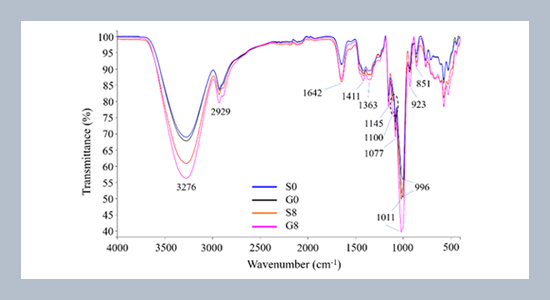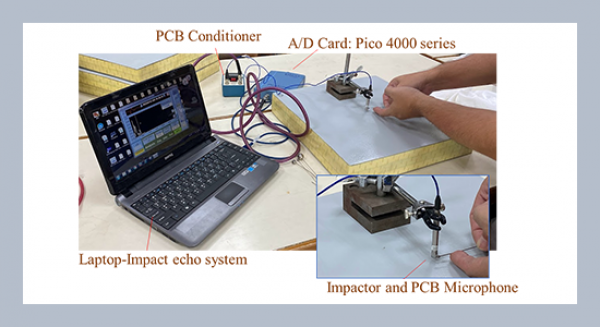REFERENCES
- Alonso-González, M., Felix, M., Romero, A. 2022. Rice bran-based bioplastics: Effects of biopolymer fractions on their mechanical, functional and microstructural properties. Polymers, 14, 1–14.
- Antunes, C., Mendes, R., Lima, A., Barros, C., Fields, P., Da Costa, L.B., Rodrigues, J.C., Silva, M.J., Correia, A.M., Carvalho, M.O. 2015. Resistance of rice varieties to the stored-product insect, Sitophilus zeamais (Coleoptera: Curculionidae). Journal of Economic Entomology Advance, 109, 445–453.
- Awasthi, S., Singhal, R. 2015. Mathematical modeling for the prediction of the overall swelling profile from Poly (AM-co-AA-co-HEA) hydrogels: Effect of glycidyl methacrylate and ammonium persulphate. International Journal of Plastics Technology, 19, 241–262.
- Basiak, E., Lenart, A., Debeaufort, F. 2018. How glycerol and water contents affect the structural and functional properties of starch-based edible films. Polymers, 10, 1–18.
- BSN. 2014. SNI 7818:2014. Kantong plastic mudah terurai.
- Ceseracciu, L., Heredia-Guerrero, J.A., Dante, S., Athanassiou, A., Bayer, I.S. 2015. Robust and biodegradable elastomers based on corn starch and polydimethylsiloxane (PDMS). ACS Applied Materials & Interfaces, 7, 3742–3753.
- Cheng, L.H., Karim, A.A., Seow, C.C. 2006. Effects of water-glycerol and water sorbitol interactions on the physical properties of konjac glucomannan films. Journal of Food Science, 71, E62–E67.
- Detduangchan, N., Sridach, W., Wittaya, T. 2014. Enhancement of the properties of biodegradable rice starch films by using chemical cross-linking agents. International Food Research Journal, 21, 1225–1235.
- Dias, A.B., Müller, C.M.O., Larotonda, F.D.S., Laurindo, J.B. 2010. Biodegradable films based on rice starch and rice flour. Journal of Cereal Science, 51, 213–219.
- Fang, J.M., Fowler, P.A., Tomkinson, J., Hill, C.A.S. 2002. The preparation and characterization of a series of chemically modified potato starches. Carbohydrate Polymers, 47, 245–252.
- Flores-Morales, A., Jiménez-Estrada, M., Mora-Escobedo, R. 2012. Determination of the structural changes by FT-IR, Raman, and CP/MAS 13C NMR spectroscopy on retrograded starch of maize tortillas. Carbohydrate Polymers, 87, 61–68.
- Geyer, R., Jambeck, J.R., Law, K.L. 2017. Production, use, and fate of all plastics ever made. Science Advances, 3, e1700782.
- Hasan, M., Gopakumar, D.A., Rizal, S., Olaiya, N.G., Zarlaida, F., Alfian, A., Aprinasari, C., Alfatah, T., Abdul Khalil, H.P.S. 2020. Evaluation of the thermomechanical properties and biodegradation of brown rice starch-based chitosan biodegradable composite films. International Journal of Biological Macromolecules, 156, 896–905.
- Inayati, Pamungkas, D.J., Matovanni, M.P.N. 2019. Effect of glycerol concentration on mechanical characteristics of biodegradable plastic from rice straw cellulose. AIP Conference Proceedings, 2097, 030110.
- Jambeck, J.R., Geyer, R., Wilcox, C., Siegler, T.R., Perryman, M., Andrady, A., Narayan, R., Law, K.L. 2015. Plastic waste inputs from land into the ocean. Science, 347, 768–771.
- Lebreton, L., Andrady, A. 2019. Future scenarios of global plastic waste generation and disposal. Palgrave Communications, 5, 1–11.
- Marichelvam, M.K., Jawaid, M., Asim, M. 2019. Corn and rice starch-based bio-plastics as alternative packaging materials. Fibers, 7, 1–14.
- Moshood, T.D., Nawanir, G., Mahmud, F., Mohamad, F., Ahmad, M.H., AbdulGhani, A. 2022. Biodegradable plastic applications towards sustainability: A recent innovation in the green product. Cleaner Engineering and Technology, 6, 100404.
- Musa, B.H., Hameed, N.J. 2021. Effect of cross-linking agent (glutaraldehyde) on the mechanical properties of (PVA/starch) blend and (PVA/PEG) binary blend films. Journal of Physics: Conference Series, 1795, 012064.
- Mustapha, S.N.H., Wan, J.S. 2022. Effect of hybridization composition and glycerin content on novel corn starch/nata de coco plastic film: Thermal, mechanical, and degradation study. Food Chemistry, 373, 131440.
- Ooi, Z.X., Ismail, H., Bakar, A.A., Abdul Aziz, N.A. 2012. The comparison effect of sorbitol and glycerol as plasticizing agents on the properties of biodegradable polyvinyl alcohol/rambutan skin waste flour blend. Polymer-Plastics Technology and Engineering, 51, 432–437.
- Oppong, D., Panpipat, W., Chaijan, M. 2021. Chemical, physical, and functional properties of Thai indigenous brown rice flours. Plos One, 16, e0255694.
- Prasetyo, D.J., Apriyana, W., Jatmiko, T.H., Hernawan, Hayati, S.N., Rosyida, V.T., Pranoto, Y., Poeloengasih, C.D. 2017. Physicochemical properties of sugar palm starch film: Effect of concentration and plasticizer type. IOP Conf. Series: Materials Science and Engineering, 223, 012049.
- Ratnawati, R., Wulandari, R., Kumoro, A.C., Hadiyanto, H. 2022. Response surface methodology for formulating PVA/starch/lignin biodegradable plastic. Emerging Science Journal, 6, 238–255.
- Retnowati, D.S., Ratnawati, R., Purbasari, A. 2015. A biodegradable film from jackfruit (Artocarpus heterophyllus) and durian (Durio zibethinus) seed flours. Scientific Study & Research: Chemistry & Chemical Engineering, Biotechnology, Food Industry, 16, 395–404.
- Sechi, N.S.M., Marques, P.T. 2017. Preparation and physicochemical, structural and morphological characterization of phosphorylated starch. Materials Research, 20, 174–180.
- Seung, D. 2020. Amylose in starch: Towards an understanding of biosynthesis, structure and function. New Phytologyst, 228, 1451–1692.
- Shafqat, A., Al-Zaqri, N., Tahir, A., Alsalme, A. 2021. Synthesis and characterization of starch-based bioplastics using varying plant-based ingredients, plasticizers, and natural fillers. Saudi Journal of Biological Sciences, 28, 1739–1749.
- Shah, N., Mewada, R.K., Mehta, T. 2016. Cross-linking of starch and its effect on viscosity behavior. Reviews in Chemical Engineering, 32, 265–270.
- Shanmathy, M., Mohanta, M., Thirugnanam, A. 2021. Development of biodegradable bioplastic films from taro starch reinforced with bentonite. Carbohydrate Polymer Technologies and Applications, 2, 100173.
- Song, J.H., Murphy, R.J., Narayan, R., Davies, G.B.H. 2009. Biodegradable and compostable alternatives to conventional plastics. Philosophical Transactions of Royal Society B, 364, 2127–2139.
- Surendren, A., Mohanty, A.K., Liu, Q., Misra, M. 2022. A review of biodegradable thermoplastic starches, their blends and composites: Recent developments and opportunities for single-use plastic packaging alternatives. Green Chemistry, 24, 8606–8636.
- Tarique, J., Sapuan, S.M., Khalina, A. 2021. Effect of glycerol plasticizer loading on the physical, mechanical, thermal, and barrier properties of arrowroot (Maranta arundinacea) starch biopolymers. Scientific Reports, 11, 13900.
- Woo. K., Seib, P.A. 1997. Cross-linking of wheat starch and hydroxypropylated wheat starch in alkaline slurry with sodium trimetaphosphate. Carbohydrate Polymers, 33, 263–271.
- World Bank. 2021. Plastic waste discharges from rivers and coastlines in Indonesia. Marine Plastics Series, East Asia and Pacific Region. Washington DC. Retrieved 2022-05-30 from https://www.worldbank.org/en/country/indonesia/publication/plastic-waste-discharges-from-rivers-and-coastlines-in-indonesia.















